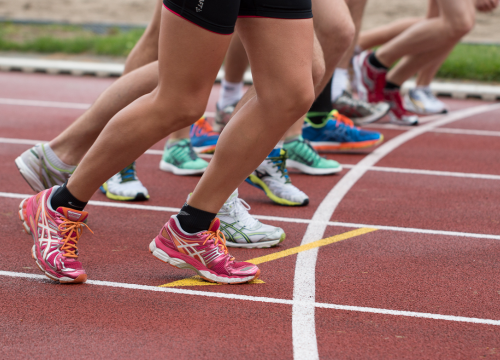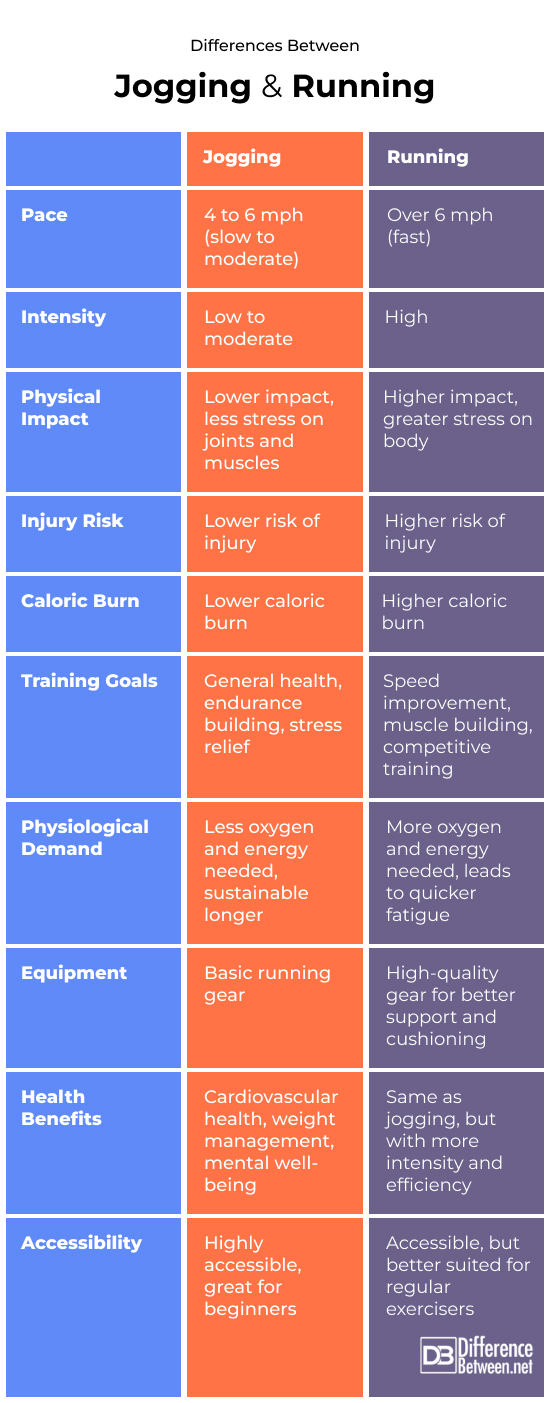Difference Between Jogging and Running
Introduction
So, we all know that staying active is super important, right? It keeps us healthy, boosts our mood, and honestly, it’s just a great way to break from our screen-filled lives. When it comes to getting that heart rate up and burning some calories, jogging and running are go-tos for a lot of us. They’re easy to start, don’t need much gear, and hey, you can do them just about anywhere.
Jogging and running are different. Both entail quickly putting one foot in front of the other, but they have different techniques and benefits. Know the difference between cruising around the block and pushing yourself for a sweaty, high-speed run to determine what’s ideal for your fitness objectives. Let’s run through their differences.

What is Jogging?
Definition
Jogging is sometimes described as slow walking or running. Their major goal is to get fitter without stressing their body like running faster. A moderate-intensity workout delivers fitness benefits while allowing for easy movement.
Key Characteristics of Jogging
Normal aerobic running speed is 4–6 mph (6.4–9.7 km/h). It takes longer than running but less than walking.
It’s easier than running. Joggers should speak easily.
Jogging posture is shorter and less rigid than running. It’s a fantastic exercise for beginners and injured people because it has less impact on muscles and joints.
Most joggers breathe steadily and under control, which matches the low intensity of the exercise.
Health Benefits of Jogging
Heart Health: Running strengthens the heart muscle and improves blood flow.
Weight Control: It burns calories and fat, preventing obesity.
Mental Health: Jogging releases endorphins, the “feel-good” hormones, which reduce stress, anxiety, and depression.
Musculoskeletal Strength: Strong bones and muscles: Jogging is gentle on the joints yet builds strength.
Longevity: Daily jogging has been found to extend life and improve health.
Jogging is an easy and healthy approach for people of all ages and ability levels to start exercising. This long-term exercise method prevents injury and improves health and emotional well-being.

What is Running?
Definition
Running is tougher than walking because you move quicker, work more, and strike the ground harder. Eventually, both feet are off the ground. This sort of walking is frequently over 6 mph (9.7 km/h).
Key Characteristics of Running
Running is quicker than walking, typically exceeding 6 mph. Because of fitness, training, and goals, this speed varies greatly.
The body needs extra energy to run. This intense workout accelerates the heart and stresses the vascular system.
Runners have longer steps and stronger arm swings than walkers. Footstriking can stress bones and joints.
Running requires more work and energy, so you breathe faster and unevenly than during jogging.
Health Benefits of Running
Running is better for your heart than walking since it increases your heart rate and lung capacity.
Caloric Burn: It burns more calories, helping you reduce weight and avoid fat.
Mental Health: Running generates more endorphins than jogging because it was harder. Your happiness and mental health can improve.
Muscle Development: Running builds and tones muscles, especially legs.
Endurance and Stamina: Regular runners have better endurance and stamina, improving their physical performance.
Common Scenarios Where Running is Preferred
- Athletes training for races or other competitive activities often choose running to enhance their speed and stamina.
- Running is hard, thus fit people or those with performance ambitions may run.
- Running is a terrific way to get a short, tough workout if you don’t have much time.
- Because of its greater impact, running may be better than walking for improving muscle and bone strength.
Running is a physical exercise and endurance test because it’s so hard. It appeals to those who wish to push themselves, improve in sports, and reach their highest workout goals.
Similarities Between Jogging and Running
Health care sharing pros:
- Both improve cardiac function and reduce heart disease risk.
- They burn calories by increasing metabolism to maintain weight.
- Endorphins reduce tension and anxiety.
- Better lung health and capacity benefit many.
- Both boost energy and sleep.
Body needs:
- Both build cardio and stamina.
- They focus on legs, hips, and core.
- To accomplish fitness goals, alter workout intensity and duration.
- Warming up and cooling down helps prevent muscular damage from both.
Standard Tools and Setups:
- Support and padding are crucial in running shoes.
- To do both, wear loose, airy clothes.
- They can be done in parks, running tracks, roads, and machines.
- Fitness monitors, water bottles, and music players improve both experiences and results.
- Both improve their experience and efficiency with fitness trackers, water bottles, and music players.
Convenience and accessibility:
- Jogging and running require little equipment or gym membership.
- Both fit various schedules and are straightforward to use.
People and places:
- Jogging and running are club-based activities.
- These workouts are appropriate for all ages and fitness levels.
Key Differences Between Jogging and Running
How rapidly and rigorously:
- Jogging at a slower, more leisurely speed of 4-6 mph is more moderate. It operates throughout time.
- Running (over 6 mph) increases muscular mass and speed.
Body impacts and potential harm:
- Running is a great way to start exercising or recover from an injury because it is a less demanding activity on the body.
- Running causes shin discomfort and stress fractures because of the increased force involved.
Goals and results of the instruction:
- Running boosts health, eases tension, and strengthens the body.
- Running is done to gain strength, speed, or race preparation.
Calorie intake:
- Jogging burns fewer calories than running.
- Running helps people lose weight by accelerating the burning of calories.
- The body needs
- Longer distances may be covered while jogging because it uses less energy and air.
- Running is harder, wears you out faster, and builds your strength.
Important tools and supplies:
- Basic running gear is usually sufficient.
- To withstand stress, running can require more robust gear.
Differences Between Jogging and Running

Summary
Jogging and running—what’s the deal? Like two sides of the same coin, each has its distinct flavor. Jogging? It’s your chill friend, going 4–6 mph. Perfect for when you don’t want to sweat but want to get healthy. Simple, low-impact, and perfect for staying fit without overdoing it.
What about running? Turn up the heat then. Consider it jogging’s intense relative, going above 6 mph. Running is like pursuing your next fitness peak. It requires more from your body, but the benefits? Well worth it.
Have you questioned, “Do I want to take it easy or push my limits today?” Your choice is jogging or running. Both have benefits – heart health, mood boost, weight loss – but it depends on your goals. What matters is hitting the pavement your way, whether you’re jogging or running hard. Don’t just count the miles—enjoy the journey. Lace up and let’s go—your way!
FAQs
Is running or jogging better for losing weight?
- Running generally burns more calories than jogging, making it more effective for weight loss. However, jogging can also help lose weight, especially for beginners or those preferring a less intense workout.
Is jogging in place as good as running?
- While jogging in place is a convenient alternative, it doesn’t offer the same level of intensity or calorie burn as running. It’s a good option for limited space or warm-up routines, but it doesn’t completely replace the benefits of running.
What is considered a jog?
- A jog is typically considered to be a slow to moderate pace of about 4 to 6 mph. It’s a comfortable speed where you can maintain a conversation without getting too winded.
Can you lose belly fat by jogging?
- Yes, you can lose belly fat by jogging. It helps burn calories and can contribute to overall weight loss, including the abdominal area. However, targeted fat loss in one specific area is not possible; fat loss tends to be overall.
Can jogging in place lose belly fat?
- Jogging in place can contribute to overall calorie burn and may aid in losing belly fat as part of a comprehensive fitness routine. However, its effectiveness is less than traditional jogging or running due to lower intensity.
Is jogging 30 minutes a day enough to lose weight?
- Jogging for 30 minutes a day can be part of an effective weight loss strategy, especially when combined with a healthy diet and strength training. The key is consistency and gradually increasing intensity or duration.
How long should I jog a day to lose weight?
- The duration depends on individual fitness levels and weight loss goals. Starting with 20-30 minutes a day and gradually increasing the time can be effective. It’s important to balance exercise with a healthy diet for optimal results.
Will running 3 times a week help lose weight?
- Yes, running 3 times a week can help with weight loss, particularly if each session is challenging and combined with a healthy diet and lifestyle. Consistency and gradually increasing the duration and intensity are crucial for effective results.
- Difference Between Suicide and Euthanasia - May 22, 2024
- Difference Between Vitamin D and Vitamin D3 - May 21, 2024
- Difference Between Running Shoes and Walking Shoes - April 30, 2024
Search DifferenceBetween.net :
4 Comments
Trackbacks
- Difference Between Tennis Shoes and Running Shoes | Difference Between | Tennis Shoes vs Running Shoes
- Difference Between Insanity and Obsession | Difference Between | Insanity vs Obsession
Leave a Response
References :
[0]Lee, D. C., Brellenthin, A. G., Thompson, P. D., Sui, X., Lee, I. M., & Lavie, C. J. (2017). Running as a key lifestyle medicine for longevity. Progress in cardiovascular diseases, 60(1), 45-55.
[1]Shipway, R., & Holloway, I. (2010). Running free: Embracing a healthy lifestyle through distance running. Perspectives in public health, 130(6), 270-276.
[2]Suter, E., Marti, B., & Gutzwiller, F. (1994). Jogging or walking—comparison of health effects. Annals of epidemiology, 4(5), 375-381.
[3]Lobstein, D. D., Rasmussen, C. L., Dunphy, G. E., & Dunphy, M. J. (1989). Beta-endorphin and components of depression as powerful discriminators between joggers and sedentary middle-aged men. Journal of Psychosomatic Research, 33(3), 293-305.
[4]1 Suter, E., Marti, B., & Gutzwiller, F. (1994). Jogging or walking—comparison of health effects. Annals of epidemiology, 4(5), 375-381.
[5]2 Suter, E., Marti, B., & Gutzwiller, F. (1994). Jogging or walking—comparison of health effects. Annals of epidemiology, 4(5), 375-381.
[6]3 Suter, E., Marti, B., & Gutzwiller, F. (1994). Jogging or walking—comparison of health effects. Annals of epidemiology, 4(5), 375-381.
[7]4 Suter, E., Marti, B., & Gutzwiller, F. (1994). Jogging or walking—comparison of health effects. Annals of epidemiology, 4(5), 375-381.
[8]5 Lobstein, D. D., Rasmussen, C. L., Dunphy, G. E., & Dunphy, M. J. (1989). Beta-endorphin and components of depression as powerful discriminators between joggers and sedentary middle-aged men. Journal of Psychosomatic Research, 33(3), 293-305.
[9]6 Suter, E., Marti, B., & Gutzwiller, F. (1994). Jogging or walking—comparison of health effects. Annals of epidemiology, 4(5), 375-381.
[10]7 Schnohr, P., Marott, J. L., Lange, P., & Jensen, G. B. (2013). Longevity in male and female joggers: the Copenhagen City Heart Study. American journal of epidemiology, 177(7), 683-689.
[11]8 Lee, D. C., Brellenthin, A. G., Thompson, P. D., Sui, X., Lee, I. M., & Lavie, C. J. (2017). Running as a key lifestyle medicine for longevity. Progress in cardiovascular diseases, 60(1), 45-55.
[12]9 Shipway, R., & Holloway, I. (2010). Running free: Embracing a healthy lifestyle through distance running. Perspectives in public health, 130(6), 270-276.
[13]10 Shipway, R., & Holloway, I. (2010). Running free: Embracing a healthy lifestyle through distance running. Perspectives in public health, 130(6), 270-276.
[14]11 Shipway, R., & Holloway, I. (2010). Running free: Embracing a healthy lifestyle through distance running. Perspectives in public health, 130(6), 270-276.
[15]Image credit: https://www.canva.com/photos/MAEJLQ6dlgU-jogging/
[16]Image credit: https://www.canva.com/photos/MADGyBPaG-4-people-doing-marathon/

This is a nice explanation between jogging and running. When I searched on Google the first result is some other page that does not tell me any difference just the author opinion, it sucked. This should be the first result. I also liked the end where you gave the summary. Thanks for the great article.
The problem with the above analogy is:
It’s stating the fundamental difference between jogging & running is speed & exertion. Where this falls apart is Olympic speed walkers can race at 10mph or putting that in perspective, that’s a 36 minute 10km (6 mile)!
You can also run at walking pace. Where I would probably agree to some extent, is that ‘joggers’ generally are pretty relaxed in their approach to their exercise.
My take on the difference is as follows: There are 3 unique disciplines – Walking, Jogging & Running. Each have their own fundamental elements as detailed below:
Walking – The body is in an upright position (occasionally bending forward from the waist) with a heel to toe gait (landing on the heel & pushing off from the toes) & spaced roughly hip distance between the feet on landing. One foot is in contact with the ground at all times.
Jogging – The body is in an upright position (occasionally bending forward from the waist) with a heel to toe gait (landing on the heel & pushing off from the toes) & roughly hip distance between the feet on landing. Both feet leave the ground when travelling. There is also a low heel lift to the rear & low knee lift to the front.
Running – The body leans forward from the foot, there is a high heel lift to the rear & high knee lift to the front (comparatively to jogging) the main forward momentum is achieved by driving off from the mid / fore foot & assisted by gravity (falling forward). The feet land roughly in line, as if you were running along a tight rope.
If you want to see how top runners run, watch top flight athletes competing, either in the Diamond League athletic events or the elite marathon runners leading the pack at one of the major marathons.
How you choose to run / jog is entirely up to you & in the overall scheme of things doesn’t really matter, if it makes you happy & helps to keep you healthy it’s all good.